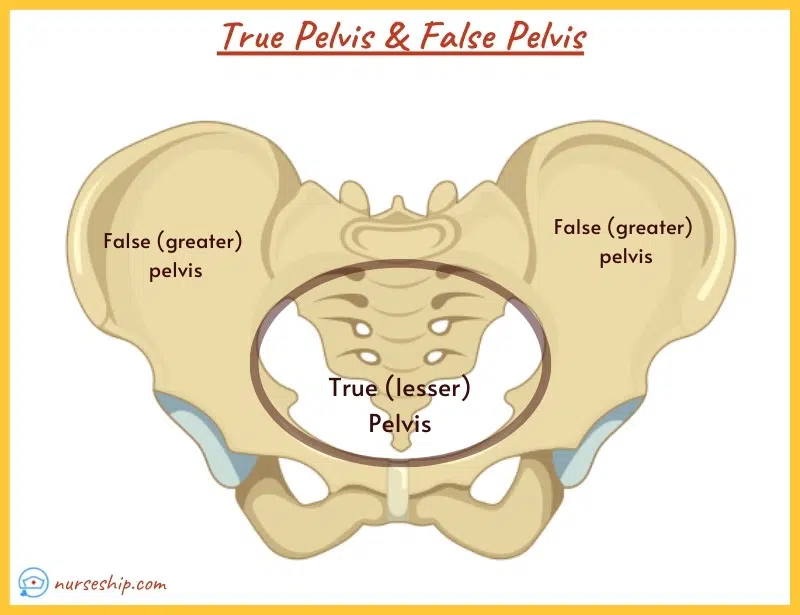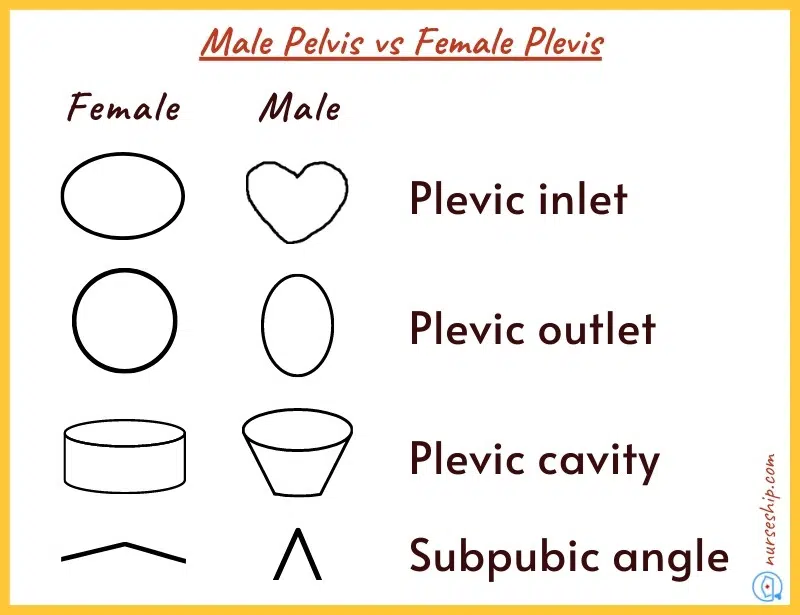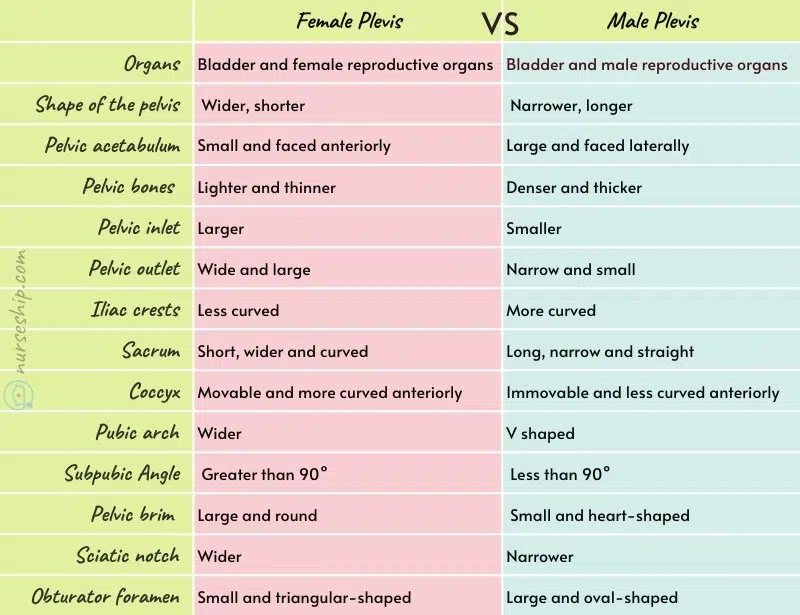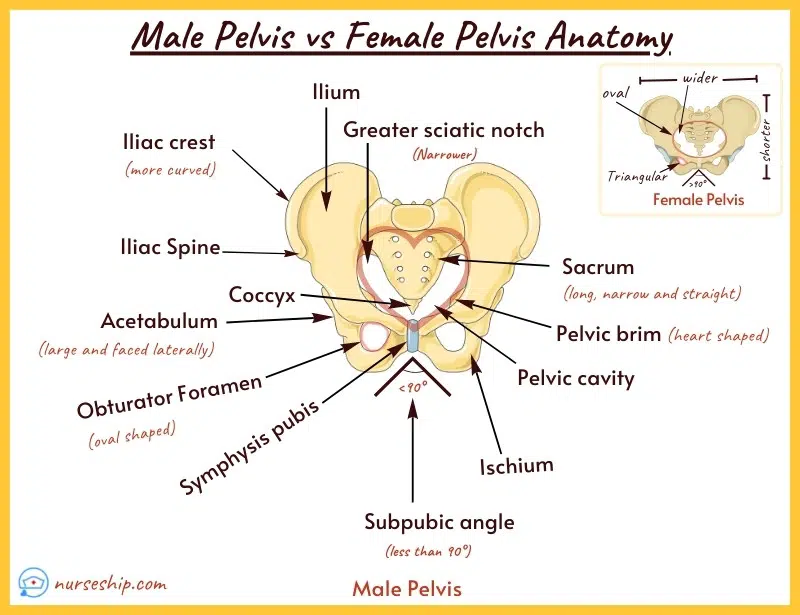Last updated on December 28th, 2023
Male Pelvis vs Female Pelvis
In this article, you will learn about the male pelvis vs female pelvis anatomy including their similarities and differences.
The term pelvis is loosely used to describe the region where the trunk and lower limb meet.
The bony pelvis is made up of four bones that are joined at four joints.
They are the two hip bones (os coxae) which form the anterior and lateral walls, the sacrum, and the coccyx.
The four pelvic joints are the sacroiliac joint, lumbosacral joint, pubic symphysis, and the sacrococcygeal joint.
What are the main differences between a male and female pelvis?
The main differences between male and female pelvises are shape, size, and function.
- The sacrum is wider and shorter in females, whereas it is longer and curved in males.
- The angle of the pubic arch is wider in females than in males.
- Females have less prominent promontory and ischial spines, but males have prominent projecting and inverted ischial spines.
- The bones of the male pelvis are heavier and thicker when compared to female pelvic bones which are dense and thinner.
Other differences between the male and female pelvises are discussed in greater detail below.
Why are male and female pelvis different?
Male and female pelvises differ because they serve different functions in both genders.
For instance, the male pelvis is designed to support their heavy body build and stronger muscular structure.
Whereas the female pelvis anatomy is primarily designed to support the childbearing process.

Human Anatomy & Physiology Course
- Guidebooks
- Complete Diagrams & Lessons
- Certifications
- Quiz & Answers
- And More…
Pelvis (Similarities)
The bony pelvis is composed of the os coxae, the sacrum, and the coccyx in both males and females.
These bones connect the axial skeleton to the lower limbs and therefore play a role in bearing the upper body’s weight.
Pelvic joints include the sacrococcygeal, lumbosacral, pubic symphysis, and sacroiliac.
In both sexes, they protect the pelvic organs (such as the lower intestine, reproductive organs, rectum, and urine bladder) and support the trunk.
Pelvis also serves as a point of attachment for the legs.
True pelvis and False pelvis
The pelvis is divided into two regions. Namely, greater or false pelvis and lesser or true pelvis. The linea terminalis is the pronounced line separating the false and true pelvis.
The sacral promontory, pectineal line, arcuate line, and pubic crest together make up the greater (or false) pelvis. The false pelvis is surrounded by the superior pelvic girdle. The inferior abdominal viscera occupy it, providing them with protection.
The lesser (or true) pelvis is surrounded by the inferior pelvic girdle, which provides the skeletal framework for both the pelvic cavity and the perineum—compartments of the trunk separated by the musculofascial pelvic diaphragm.

Pelvic girdle
The pelvic girdle is the foundation of both the male and female pelvis.
The two large bones of the hip are known as the os coxae, also known as the coxal bone or the innominate bone. In both men and women, they make up the pelvic girdle.
The os coxae or the hip bones are made up of three fused bones. They are the ilium, ischium, and pubis.
Male pelvis vs female pelvis: Pelvic bones
The pelvic bones in the male are heavier, longer, and thicker whereas the pelvic bones are dense and thinner in females.
Male pelvis vs female pelvis: Sacrum
The sacrum is a shield-shaped bony structure located at the base of the lumbar vertebrae and attached to the pelvis. The sacrum forms the posterior pelvic wall and strengthens and stabilizes the pelvis.
The male sacrum is long, narrow, straighter, and has a pronounced sacral promontory. The female sacrum is shorter, wider, more curved posteriorly, and has a less prominent promontory.
Male pelvis vs female pelvis: Coccyx
The coccyx in the male pelvis is projected inwards and immovable, while a female pelvis has a flexible and straighter coccyx.
Male pelvis vs female pelvis: Shape
Male pelvises are longer and narrower overall.
The female pelvis, on the other hand, is shorter and wider in overall shape.

Male pelvis vs female pelvis: Pelvic inlet
The pelvic inlet is the anatomical limit between the true pelvis below and the false pelvis above.
Its boundaries are posteriorly sacral promontory, laterally iliopectineal lines, and the anterior symphysis pubis.
The pelvic inlet in females is larger, oval, and rounded. While in the male, it is small and heart-shaped.
Male pelvis vs female pelvis: Pelvic outlet
The pelvic outlet is an approximately diamond-shaped space that marks the inferior margin of the true pelvis.
Its boundaries are posteriorly the coccyx, the ischial tuberosities laterally, and the pubic arch anteriorly.
The pelvic outlet is narrower in males and wider in females.
Male pelvis vs female pelvis: Pelvic cavity
The pelvic cavity is the hollow space surrounded by pelvic bones and it contains pelvic organs such as the urinary bladder, rectum, parts of the colon, and internal reproductive organs.
The pelvic cavity and the abdominal cavity together form the larger abdominopelvic cavity. There is no anatomically distinct structure that separates both cavities.
The true pelvis is wide and shallow in the female, and the pelvic inlet, also known as the superior pelvic aperture, is wide, oval, and rounded. While in the male, it is heart-shaped and narrow.
Male pelvis vs female pelvis: Pelvic brim
The pelvic brim is the edge of the pelvic inlet and divides the pelvis into two parts. The false pelvis that bounds the lower part of the abdominal cavity is above the brim. The true pelvis, which contains the pelvic cavity, is below the brim.
The pelvic brim is narrow and heart-shaped in males, whereas it is large and circular in females.
Male pelvis vs female pelvis: Ilium
Ilium is the largest and uppermost bone of os coxae. The ilium is comprised of a small inferior part that makes up two-fifths of the acetabulum and a small, flared, expanded upper part that forms the iliac crests and spines.
The landmarks of the ilium include the iliac crest, anterior superior spine, anterior inferior spine, posterior superior spine, posterior inferior spine, iliac fossa, and greater sciatic arch.
Differences
Males have a more vertical ilium, resulting in a curvier iliac crest than females.
The female pelvis has a greater distance between the anterior superior iliac spines than the male pelvis.
Male pelvis vs female pelvis: Ischial tuberosities
The large, roughened area of the inferior ischium is the ischial tuberosity. This serves as the attachment for the posterior thigh muscles and carries the body’s weight when sitting.
The ischial tuberosities are longer, narrower, heavier, and point inward to the pelvic cavity.
In females, the ischial tuberosities are shorter, wider, and pointed outwardly in the pelvis.
Male pelvis vs female pelvis: Acetabulum
The acetabulum is the area of the pelvis where the upper end of the thigh bone (the femoral head) meets the pelvis to form the hip joint. It is a cup-like socket formed by connecting the coxal bone (ilium, ischium, and pubis).
In the male, the pelvis faces more laterally while in the females the pelvis faces anteriorly. The male acetabulum has a smaller anteversion and inclination than the female acetabulum.
Male pelvis vs female pelvis: Pubic arch/ subpubic angle
The pubic arch is a notched area under the pubic symphysis.
The subpubic angle (or pubic angle) is formed at the pubic arch by the convergence of the inferior rami of the ischium and pubis on either side.
The width of the subpubic angle is determined by the distance between the right and the left ischial tuberosities.
Male subpubic angle is less than 90° in males and it is more than 90° in females.
Male pelvis vs female pelvis: Ischiopubic ramus
Ischiopubic ramus is formed by the inferior ramus of pubis and the inferior ramus of ischium. It forms the inferomedial boundary of the obturator foramen.
In females, the ramus has a sharp, narrow edge, whereas it is flat and blunt in males.
Male pelvis vs female pelvis: Greater sciatic notch
The greater sciatic notch is a notch in the ilium between the posterior inferior iliac spine and the ischial spine.
The sacrospinous ligament changes this notch into an opening, which is known as the greater sciatic foramen. This is where the sciatic nerve exits.
The females have a wider greater sciatic notch when compare to their counterparts.
Male pelvis vs female pelvis: Ischial tuberosities
The large, roughened area of the inferior ischium is the ischial tuberosity. This serves as the attachment for the posterior thigh muscles and carries the body’s weight when sitting.
The ischial tuberosities are longer, narrower, heavier, and point inward to the pelvic cavity. In females, the ischial tuberosities are shorter, wider, and pointed outwardly in the pelvis.
Male pelvis vs female pelvis: Obturator foramen
The obturator foramen is an opening between the ischium and pubis of the hip bone. It is closed by the obturator membrane, except for the obturator canal. The obturator nerve and blood vessels pass through it.
Obturator foramen is larger and oval-shaped in males, and smaller and more triangular in females.
Male pelvis vs female pelvis: Ventral arc
The ventral arc is a slightly elevated ridged surface on the ventral side of the female pubic bone.
The ventral arc serves as an attachment site for various muscles including the gracilis, adductor brevis, and adductor magnus.
It is one of the features of the pelvic bones that are examined to identify the biological sex of an individual. A true ventral arc is present only in females. A ridge of bone along the ventral aspect of the pubis can also be found in males.
However, the angle and orientation of this bony ridge are different in males and females, allowing distinctions between both sexes.

Conclusion
In this article, we discussed male vs female pelvis anatomy.
The male and female pelvises differ primarily in shape, size, and function. Furthermore, male pelvic bones are heavier and thicker than female pelvic bones, which are dense and thinner.
The pelvis has some structural differences in males and females. The male pelvis plays an important role in supporting the heavy body build and large muscles.
Primarily males and females differ have structural and functional differences.
That’s why it is thicker and denser. The female pelvis is designed to help the childbearing and ease the child delivery process; that’s why it is wider and has a larger pelvic inlet.
References
Lippincott Williams & Wilkins. (2009). Anatomy and physiology made incredibly easy! (3rd ed.).
Cohen, B., & Taylor, J. (2009). Memmler’s Structure and Function of the Human Body, 8th ed (10th ed.). Lippincott Williams & Wilkins.
Moini, J. (2020). Anatomy and Physiology for Health Professionals (3rd ed.). Jones & Bartlett Learning, LLC.
Standring, S., Anand, N., Birch, R., Collins, P., Crossman, A., & Gleeson, M. et al. (2016). Gray’s Anatomy: The Anatomical Basis of Clinical Practice (41st ed.). Elsevier Limited.
Thompson, G. (2015). Understanding Anatomy & Physiology: A visual, auditory, interactive approach (2nd ed.). F. A. Davis Company.



